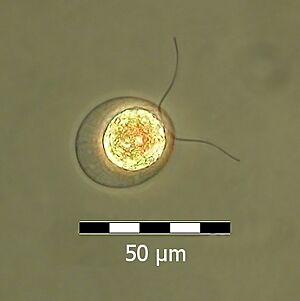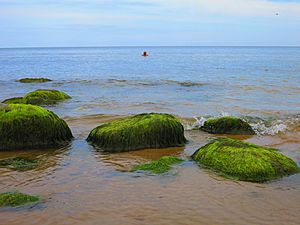Chlorophyta facts for kids

Chlorophyta are a big group of organisms often called green algae. They are a type of green algae.
There are about 7,000 different kinds, or species, of green algae. Most of them live in water. They are eukaryote organisms, which means their cells have a nucleus.
Green algae are amazing because they can make their own food. They do this through a process called photosynthesis. This is just like how land plants make their food.
They use special green pigments called chlorophylls a and b to capture sunlight. They also store their food as starch inside parts of their cells called plastids.
Many green algae species have tiny whip-like tails called flagella. They use these tails to swim around during at least one part of their life cycle.
Contents
What Are Green Algae?
Green algae are closely related to land plants. They are part of a larger group called Viridiplantae. This group includes all green plants and their closest relatives.
Some green algae are made of just one cell. Others are made of many cells, forming larger structures.
Where Do Green Algae Live?
Most green algae live in freshwater places like lakes and rivers. Many also live in the ocean.
But some green algae can live in very unusual spots! For example, a type called Chlamydomonas nivalis lives on summer snowfields. It makes the snow look pink or red, which is why it's sometimes called "watermelon snow."
Other green algae can be found stuck to rocks. You might also see them on the woody parts of trees.
Working Together: Symbiosis
Green algae are good at working with other living things. This is called a symbiotic relationship. It means two different organisms live closely together and often help each other.
For example, some lichens are a partnership between fungi and green algae. The algae make food using sunlight, and the fungi provide a safe place to live.
Green algae also form partnerships with other creatures. These include tiny protozoa, sponges, and cnidarians like jellyfish.
Life Cycle and Reproduction
Green algae can make new algae in different ways. Some types of green algae can have sexual reproduction. This means they combine genetic material from two parents to create new offspring. This helps them adapt and survive.
Images for kids
-
Green algae on coastal rocks at Shihtiping in Taiwan
-
"Siphoneae" from Ernst Haeckel's Kunstformen der Natur, 1904
See also
 In Spanish: Clorófitas para niños
In Spanish: Clorófitas para niños




